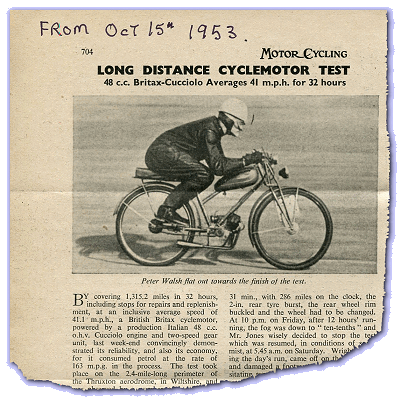Besides running Iceni CAM webzine, Andrew and I also serve as dating officers for the East Anglian Cyclemotor Club (EACC), where we’re recognised by DVLA for dating and registration services. Over the years we get to see and process a LOT of bikes and, generally, we can readily identify most of them. Many are straightforward, some are difficult, but there are the very occasional ones that prove to be just downright impossible.
This article is dedicated to the cycle chassis of a couple of that slimmest 0.2% that have defeated identification, so can only be registered according to the make of the engine. Since they’re both cyclemotors, that’s sort of acceptable anyway, since clip-on cyclemotors are primarily registered by their make of engine, and the frame serial is only recorded as the secondary field, but it’s so annoying when things defy identification.
Both machines are Italian cyclemotors, and the first of our unidentified frames carries a very familiar four-stroke engine.
Torinese designer Aldo Farinelli began work in wartime Italy during 1943, developing a very small capacity engine that could be used as a ‘clip-on’ attachment to virtually any bicycle. This low-compression four-stroke engine displaced just 48cc and produced around a single horsepower in a diminutive package weighing just 17 pounds (less than 8kg) complete and including the pre-select two-speed transmission. When the running prototype in 1944 produced a decided bark from its exhaust note, Farinelli dubbed the little engine the Cucciolo.
Although Italy signed an armistice with the Allies on 8 September 1943, Germany still occupied the north of the country, setting up a puppet state: the Republis of Salò. It was not until 29 April 1945 that the remaining German forces in Italy surrendered and the Italian industrial and commercial sector could try to recover by rebuilding its factories and launching new products. One of these companies was SIATA, which in 1945 was already able to restart its factories in via Leonardo da Vinci, Turin, having been rebuilt on the ashes of its old factory. At the Turin Motor Show on 26 July 1945, SIATA announced that it would producing Farinelli’s Cucciolo engine design, along with the ability for it to be attached to virtually any bicycle. Nominal specifications for the Cucciolo engine described it as an air-cooled, single-cylinder, overhead-valve four-stroke of 48cc, with 39mm bore and 40mm stroke. Transmission was by two-speed pre-selection with hand-operated clutch and pedal-operated shifter, then final drive to the rear wheel by the usual cycle chain. Ignition was by flywheel magneto, and a 9mm Feroldi carburettor claiming a fuel efficiency of 1 litre per 100km (roughly 235mpg). The presentation immediately aroused great public interest and SIATA proceeded with manufacturing of Farinelli’s Cucciolo.
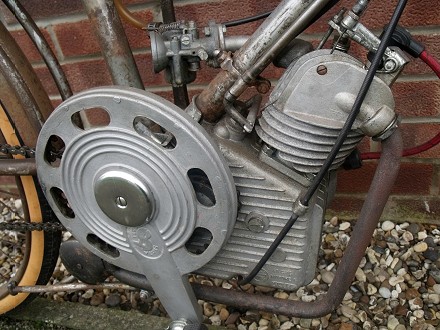
The first model (T1-a) was produced mainly in 1945 and just sold in the Turin area. The design was modified and, by March 1946 the first ten pre-production Cucciolo di Tipo T1-b were completed and, subsequently, presented at the Milan Trade Fair in September 1946, following which orders for the Cucciolo proved far greater than SIATA had ever imagined! It became clear right away that SIATA didn’t have anywhere near the capacity required to satisfy such a high demand for the motor and, after a few months, the Ducati Company decided to acquire the Cucciolo production rights from Farinelli and SIATA to expand production.
Ducati originated from an incredibly humble beginning, in fact, they didn’t make motor cycles or engines at all! It was in 1926, when an Italian named Antonio Cavalieri Ducati and his three sons founded a company in the name of Società Scientifica Radio Brevetti Ducati (Ducati Scientific Radio Patent Company) in Bologna, to produce vacuum tubes, condensers and other radio components.
The family built Ducati into a reasonably successful business, thereby securing a factory in the Borgo Panigale area to enable manufacturing on a larger scale in 1935. By the late thirties it had grown to become one of the largest manufacturers in Bologna. Heading into the Second World War, the company generally managed to maintain production despite the factory being a repeated target of allied bombing; though in the end the factory became fairly devastated. After the war, the brothers were eager to get back to work making just about anything they could and, with the help of Italy’s nationalized investment bank, the IRI, Ducati took over the manufacture of the Cucciolo. In the same year, Ducati launched a new model Cucciolo T2 with a revised design of the original: more robust, more efficient and easier to build. The power rating for initial versions of the T2 motor was raised to around 1.25bhp @ 5,500rpm, while further developments seem to have raised the output to 1.4bhp, then 1.5bhp.
Given the shaky situation of the Ducati brothers’ own financing, the IRI soon took control of Ducati completely. While the engine gambit did not work out in favour for the Ducati family, it became a massive success for Ducati the company.
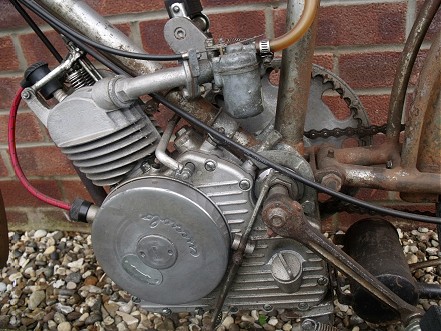
The Ducati clip-on engine used a bike’s own chain for power transmission and a small fuel tank fitted to the bike’s frame. To select low gear, the rider moved the left pedal forward, and then pulled the handlebar-mounted clutch lever to engage the gear. For high gear, the rider would pre-select using the right pedal and then the clutch to engage. Jump-starting was as easy as starting off in neutral by pedalling (it was a modified bicycle, after all) and then simply bump-starting the machine in gear.
With its incredible fuel efficiency and advantage over two-stroke engines that needed oil added to the fuel, the Cucciolo engine became immensely popular both in Italy and other European countries. Along with making several hundred thousand engines, Ducati also began selling and racing complete, assembled bikes using the same Cucciolo name. Within a few years, by the mid-fifties, Ducati had begun designing its own engines with a unique design, which would have been impossible without the Cucciolo ‘little puppy’ to launch the new motor cycle focused business.
Our engine is an exposed valve type T2, displaying serial 214639, is an early model dating 1949, and there’s an old 1956 Italian tax disc fixed to the frame, but this displays no indication of its make.
The frame has twin top tubes and wears serial 60341, but offers no clue as to its make, and neither does anything else on the bike, since most paint seems to have been cleaned off back to its metalwork-then left to go rusty.
Our presumption is that the bike was a ‘pre-build work in progress’.
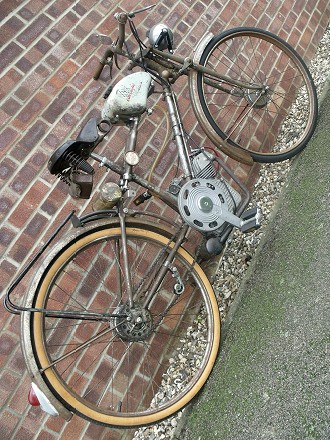
This looks to have been a frame specially made and intended to carry the Cucciolo engine, since its style and construction wouldn’t have been normal for use as a bicycle. The frame was obviously made with swinging arm rear suspension, possibly originally sprung by rubber bands, which presumably snapped so it was converted to compression spring rear suspension. This is sprung from two barrels, welded into the top frame tubes and connected to the modified swinging arm frame by a pivot link. This looks like a home-made conversion but, in our opinion, the choice of springs was considerably underrated, with the conclusion that the back-end just seems way too soft and feels as if it develops too much ‘floating’ movement in its joints.
Even before mounting the bike, our impression was that the rear frame felt badly undersprung, or maybe its creator weighed less than a 100lb race jockey?
There’s a set of Errebi girder forks (made at Luzzara in Italy) in the steering head, and fitted with a CEV TA95 headlamp but, since Errebi was a proprietary fork manufacturer, it’s likely the unknown frame maker bought these and fitted them to the chassis.
The front tyre is marked 35–584 (26×1½), and the rear 44–584 (26×1¾).
Slipping the bike across the scales gives weights of 2st 8lb front and 2st 10lb rear, so a total of 5st 4lb (74lb—just less than 34kg). The frame is fitted with a ‘Sprint’ Croupon (French) sprung-frame leather saddle and a reproduction SIATA chain-wheel.

Since the bike is so light, we try a bit of a bounce test on the frame front and rear, and are now becoming quite concerned about the prospect of riding this machine with such an undamped pogo effect…
The controls are obviously going to be difficult at best. The left handlebar lever is the clutch, which feels surprisingly heavy in operation for such a small capacity motor. The two-speed gear-change is mounted on the right-hand side of the frame down tube, and is topped by a wooden ball knob; move left for second, middle for neutral, right for first. A heavy action of the gear lever might be partially attributed to it having three hinge pivots down its linkage rod, which moves another selector rod to the motor. It’s certainly a stiff change and bodes highly likely to be difficult to operate when riding.
The throttle is controlled by the right-hand twistgrip, and the right-hand handlebar lever operates the linked brakes by means of two cables going out to both the front and rear brakes. These linked brakes are never good because they halve the amount of pressure that can be delivered by just one hand, and we’re not sure they’re legal for British highway use, which requires two independent braking systems.
By some improvised bracketry, the Ducati Cucciolo kit’s cyclemotor tank is forward mounted on the top frame tubes in motor cycle style, while the fuel tap turns on at the bottom right of the tank, off–on–reserve, and there’s a flood button on the top of the float chamber of the Weber carburettor for enrichment to start.
The only way you’ll start this machine is by pedalling up the road, because you’re never going to get it going on the dainty and delicate home-made stand.
Engage whichever gear you fancy: first may require more effort, so we choose second, hold in the clutch and pedal off, then drop the clutch and keep pedalling while randomly twisting the throttle till the motor coughs into life.
Alternatively, you can hold in the valve lifter lever beneath the left handlebar to decompress, pedal off with the engine turning over, and drop the valve lift lever instead. Either method works much the same, but what you can’t do is work both levers at the same time just with your left hand.
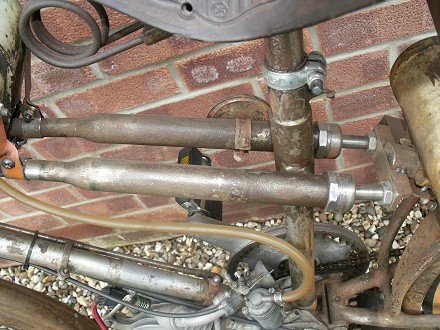
It’s every bit as awkward to ride as we could possibly have imagined!
The gear change is so stiff and clumsy that you can’t effectively use it, and since the motor runs so badly at low revs, it usually cuts out before you can effect any change at all. It proves best to start in second, and just stay in second, then help the motor at low revs with a bit of pedal assistance.
The clutch proves so stiff that your left grip soon tires of it, while you haul so hard on the single right-hand linked-brake lever to such negligible effect that you quickly conclude that the brakes are completely ineffective.
The Errebi forks spring up and down in a wobbly, bouncy and undamped motion, and certainly don’t feel at all firm enough through a corner. The forks are probably suffering wear in their pivot rods and bushes, so as soon as you enter any turn there’s that terrifying moment of doubt, and you’ll never have any confidence in this front-end to corner at speed.
The rear suspension pretty much bottoms out to coil bound as soon as you sit on the bike, and only bounces off compression occasionally when you hit a bump—utterly useless.
Overall, the handling is abysmal and the bike has the cornering ability of a wet sponge thrown down the road.
The lights didn’t work, because they didn’t seem to be wired, and a paced 26mph was the best we could wring out of the bike on a downhill run.
We were glad to make it back to base and park up, happy in the knowledge that we wouldn’t have to ride the wretched thing again. It’s nothing but a complete death trap!
One of these days, maybe we’ll get to ride a Ducati Cucciolo that actually works properly and performs like the legend is supposed to … in the meantime we’re more inclined to think their supposed performance is more myth than reality. Maybe one day (if we ever get the chance), it’d be something to put a ‘Cuc’ up against a Mercury Mercette. This was a total disastrous 2-speed hand-changed, 46cc four-stroke moped for Mercury, but rated at 2bhp and, from what we’ve seen so far, my money would be firmly on the Mercette.
In 1985, fellow Italian motor cycle manufacturer Cagiva, based out of Varese, bought Ducati and planned to re-badge Ducati motor cycles with the ‘Cagiva’ name. By the time the purchase was completed, however, Cagiva had decided to keep the ‘Ducati’ name on its motor cycles. Eleven years later, in 1996, Cagiva accepted an offer from Texas Pacific Group to sell a controlling 51% stake in the company for US$325 million; then, in 1998, Texas Pacific Group bought most of the remaining 49% to become the sole owner of Ducati.
In December 2005, Ducati returned to Italian ownership with the sale of Texas Pacific’s stake (minus one share) to Invest Industrial Holdings, the investment fund of Carlo and Andrea Bonomi. Today, Audi AG’s Automobili Lamborghini SpA subsidiary owns 100% of the shares of Ducati Motor Holding SpA after a takeover on 19 July 2012 for €747 million.
Our second 0.2% mystery machine is powered by a Garelli 38–B Mosquito cyclemotor engine, which Garelli introduced in 1953 as their third version of the Mosquito motor. The first version was the type-307 38.5cc clip-on engine in 1947, followed by the fairly brief BMG (Bici Mosquito Garelli) 315-model in 1951, with increased 40mm bore × reduced 39mm stroke now resulting in a 49cc under-square specification for a higher 1bhp rating at the same revs.
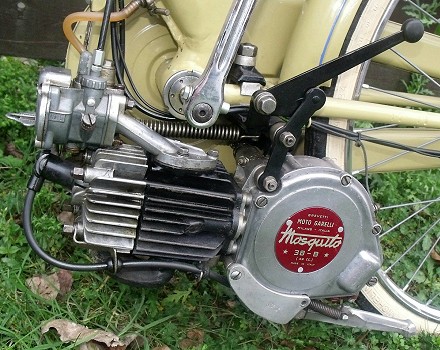
The version 38–B version Mosquito employed the preceding BMG 315 engine, but omitted the internal reduction gear, so the drive roller located directly on the crank journal. Despite a compression ratio posted at just 5.5:1, the motor still quoted the same 1bhp, but was re-rated at a lowly 2,800rpm.
‘Centrimatic’ versions of the 38–B subsequently went on to equip the engines with a centrifugal clutch
Our 49cc Garelli Mosquito 38–B engine has a cast iron cylinder with an alloy head and direct roller drive. It carries serial 769174 and dates from 1955. The motor is engaged by means of an over-locking lever set low on the left hand side, switched forward for drive and back for disengage and, because the lever position is inaccessible from the riding position, it’s not possible to use this to provide any clutching function.
In operation the bike is effectively in permanent direct-drive, so requires constant stopping and restarting by use of the decompresser lever under the left handlebar.

Roller pressure is readily adjustable onto the rear tyre according to the conditions, by screwing a wing nut above and in front of the engine, and indicating is positions as ‘Bagnato–Asciutto’. The wing nut adjusts pre-tension on a coil spring that pulls the engine onto the tyre when the over-locking lever is engaged.
The motor is fitted with a dainty cast alloy stand that also characterised many of the early Mosquitos.
Despite extensive research efforts, we’ve been unable to identify the make of this particular cycle chassis, which has been completely repainted to obliterate any original references. It has a pressed-steel main spine frame, which doubles up as the fuel tank—in a similar form to that popularised by several Italian manufacturers of the period. The pressings appear different from BMG, Cassalini, Ceccato, Nasetti, and Paglianti, so those makes are readily ruled out, and a particularly distinctive feature of our mystery frame is the inverted lifting handle in the crook of the frame. All other manufacturers welded their lifting handles the other way up, in a convex orientation, but this one is fitted concave. We’d really appreciate any suggestions to identify the make please…
Most other makers of this style of frame also tended to fit girder fork sets, but this frame mounts a telescopic fork set, so maybe it could be a little later than many other makes?
Tyres are marked 26×1½×1⅝ for 1½" rim, 650B Semi-comfort, 44–584, and the wheels are built onto half-width hubs with decent sized 100mm brakes.
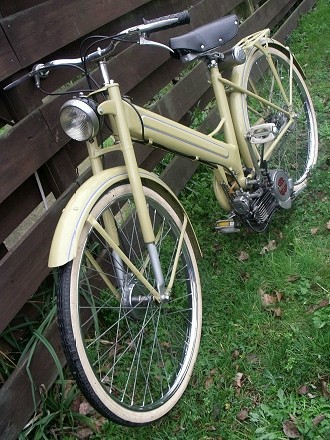
Rolling over the scales gives us weights of 2st 5lb front & 2st 10lb rear, so a total of 5st 1lb (71lb, just over 32kg).
Other controls comprise conventional right (front) and left (rear) brake levers on the bars, and a twistgrip throttle, so very minimal equipment, leaving a tidy bar-set where you can appreciate the pleasant natural curves of the tubing.
The Dell’orto carburetter is only equipped with a flood button to the float chamber, and seemingly no other means of enrichment, so starting is a bit of a guessing game … turn on the fuel tap, but should we flood the carburetter? We give it a try, lock on the drive, decompress, pedal up the road, drop the decompresser and keep pedalling while jockeying the throttle twistgrip … to no effect. Oh dear, maybe we flooded it?
Take the plug out and clean it up, spin over the motor with the plug out to vent it out, then try again without flooding … to no effect again. Maybe we didn’t flood it enough?
So we give the flood button a good long press, and try again, and after more pedalling, are encouraged slightly by a couple of pops. We stop to flood again, and following a couple more faltering attempts, finally get the motor to catch, so cruise gently up and down the road to try and settle our nervous mount.
The motor proves very tractable and docile at low revs, pulling gently around quite low speed turns, and then softly pulling up the pace in response to the twistgrip. The exhaust note sounds very pleasant under load, developing a mellow popping tone … all very nice.
Low speed handling of the frame seems very positive, and the brakes feel promising, so we coast back to base to muster our pacer.
Barely ten minutes later, and we’re ready to go, but the Mosquito again seems reluctant to start, so we have to repeat the same encouraging rigmarole with lots of flooding of the float chamber. Following the same faltering starting pattern, we finally get underway with our pacer taking readings, since the Mosquito has no speedometer.
Describing acceleration as the gradual building up of speed in response to the throttle would be a generous use of the term—it’s like a librarian and seems to do everything softly and gently. Generally it proves more effective to pedal assist up towards the speed you want to get to, and then the motor goes along with the suggestion, and holds the speed. Comfortable cruising is found up to 20mph, at which the motor feels pleasant and happy. Beyond this, by hanging onto the throttle, you can just about tease it up to a max of 23mph on the flat, where the low compression ratio of the engine doesn’t produce enough power to offer any more.
The motor certainly isn’t strained, revving, or vibrating at all at this top speed, but just doesn’t want to go any faster, then we ease back down to 20 and the 38–B ambles along contentedly again.
Our test ride was performed under slightly damp conditions and along a muddy course, and there were initially some traction issues with the cast iron drive roller slipping under throttle. This required some adjustment with the preset tension to resolve the matter, dialling the wing nut up to the full ‘Bagnato’ mark.
Under dry conditions on a lower preload setting, it might have been possible to achieve a slightly better top speed due to lower frictional losses from a lighter drive roller pressure setting.
Handling was always firm and sure-footed, both brakes were effective, and the cycle chassis gave a very pleasant ride.
Our pacer observed the lights were working during the run, but there appeared no way of turning them off. Where’s the switch? We could only presume they were direct wired to be on all the time … ahh, and there’s also no horn fitted…


